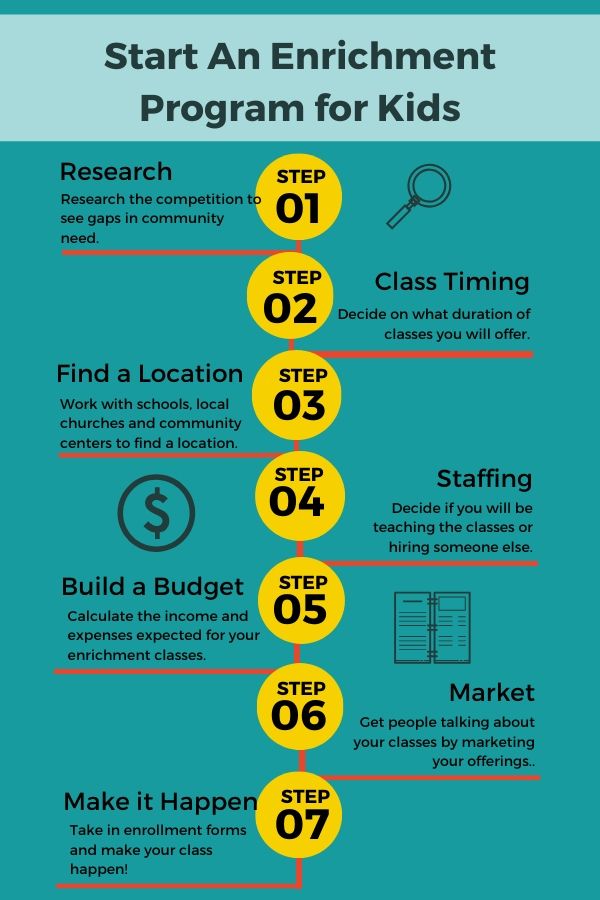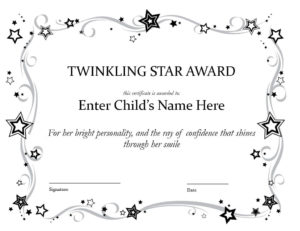Starting in an enrichment program within your after-school program can be overwhelming. To do so, you need extra staff, space and children interested in the enrichment activity. So where do you start?
1. Research Competition

The first step to start an enrichment club for kids is to make sure there is a need for the club in your community. Research clubs and classes already offered in your area. The last thing you want is to do all kinds of work to develop an enrichment club and have no interest in the program. I repeat. DO YOUR RESEARCH!
What do people want in an enrichment program?
Look into enrichment classes that would benefit your community and what classes people would value enough to pay for. You can do this by using a parent or child and interest survey, and by talking to parents and community members. The possibilities are endless. If there is a void in enrichment classes for children in your community, there’s an opportunity for growth in your program. Some examples of enrichment classes:
- Cooking classes
- Stem classes
- Foreign language
- Dance
- Karate
- Basketball skills
- Baseball camp
Look at the competition
Look into what classes are available in the community and look for holes. Some common national programs to check for include engineering for kids and girls on the run. Some communities offer classes through schools, some offer classes through libraries or a community recreation program. Make sure you thoroughly investigate the current options for enrichment courses before you commit your time to developing your own classes. Check out what classes are available, what time of day, and days of the week and duration of classes. Important questions to consider:
- What time of day are classes offered? evening? after school?
- Where are classes located?
- How large are the classes offered?
- Are classes offered year round?
- What do they charge per class?
- Who are the instructors? What credentials do they have?
After you investigate what the community wants and the competition, look for voids in programming available. Perhaps soccer is a big sport in your community, but it is only offered in the spring, your program could fill a void by offering a soccer skills class in the fall.
2. Class Timing Structure for enrichment program
After you decide on what kind of class you want to offer, decide on what duration of classes you will offer. Will you offer a class once a week for five weeks? Or will you offer a class every day for one week? The structure of the program will depend on the need in your community and the ability of your program. Again, go back to your research. If you are looking to offer a soccer skills class, see if there are other sports offered at this time that would conflict with the time or duration of your class?
Let’s say your community offers youth fall baseball that runs Monday, Wednesday & Friday from 4pm -6pm, this league runs for six weeks. You may also know the local church offers religion classes on Wednesday from 3:30-4:30. Even with just two pieces of information, you already know Wednesday is a bad day to offer a soccer skills class during this time period. It is important to get a clear understanding of everything you are competing against, then bring it together and find the best time period and duration for your class.
After you complete step 2, you should know:
- What class you are offering
- What dates/time of year it will be offered
- The duration of the class
- The days of the week the class will be offered
3. Find a Location for your enrichment program
If you are looking to offer your enrichment classes after school, you best bet is to connect with the local school district. Work with School administrators within the school to find the perfect location for your class. If the school district is not willing to rent space to your program, you can also look at local community centers or churches. Keep in mind the amenities you will need to run your class successfully. For example, if you’re hosting a cooking class you will probably need an oven or stove tops.
4. Decide on Staffing
Decide on how you your enrichment program will be staffed. Will you teach a class or will you hire from outside? If you hire someone you’re looking at a higher expense but a higher knowledge of the content area. For example, if you offer a STEM enrichment class after school and teach it you will get some interest in the program but if you staff it with someone known for their stem expertise, like a science teacher, you will likely get a higher turnout.
5. Create a Budget

You now know the important parts to building an enrichment program. Once you have decided on the big stuff, create a working budget.
Expenses
For each class you plan to offer gather your expenses, this should include:
- Staffing
- Space Rental
- Supplies
- Marketing
- Enrollment Expenses
- Misc (Anything else you can think of, better to overestimate)
Income
Add these expenses together to get the total. If you are offering your classes free of charge, continue on to step 6. But if you are looking to make a profit or break even, your budget will need income. Your income in most cases will come solely from class enrollment. Now comes the tough part. You need to decide how much you will charge for each child enrolled in each class. Let me break it down for you in an example:
Let’s say you offer a zumba class for one hour a week for six weeks. The instructor cost $30 per hour and you rent the Room for $50. You already have a wireless speaker, so there are no supply expenses. You plan on creating a few flyers to put up around town, and launching a free social media marketing campaign, so your marketing expense is $10. In order to break even, you need to make $80 per week plus cover a 1 time marketing fee of $10. For a total of $490 in expenses for your zumba class. To make a 20% return you will need to make $610 per week.
- Instructor $30
- Room Rental $50
- Marketing $10
- 6 weeks Total $490
- 20% return $610
The next step is to estimate the number of children in the class. Often the instructor will tell you they do not want more than a certain number of children in their class. In most cases an instructor will limit the enrollment to between 12 and 20, depending on the content they are teaching. Continuing from the above formula let’s say you feel you can get at least 15 children enrolled in your zumba class. Take your total expenses plus 20% and divide it by the number of children you feel you can successfully enroll in your class, in this case 15. Our formula looks like this:
$610/15 = 40.66, here I would round up to make it $42 for a 6 week zumba class. This number would profit you $140.
Calculate the Break-Even Point
After you set your rate per child set your minimum enrollment, this is usually a break-even number. The minimum will be the least amount of kids for the class to still run. Now lets say you were not as successful in recruitment as you had hoped. You could still offer the class without losing money if you could get 12 kids enrolled.
You will also set an enrollment maximum, the maximum is the most children allowed in the course (often set by the instructor). If your instructor set the max at 20 children. And you were very successful and could recruit 20 kids to enroll you would be looking at $350.
The kicker here is you cannot guarantee that enough children will enroll in your classes. My advice to you is to spread the word, talk with everyone you know and everyone you meet about the program you are offering. Then market the crap out of it.
6. Market your Enrichment Program
Advertise your classes. This is a must when you are trying to grow your program. Advertising can be done in a variety of Ways.
- Flyers
- Newspaper ads
- Social media campaigns
- Email marketing
- And the best way to market, word-of-mouth
As I mentioned above, word-of-mouth is the best marketing you can get. When people see value in the program you are offering they will talk about it. Get people talking about your program and interest will grow and so will enrollment.
7. Make it happen
After you market your class, enrollment forms will roll in. Make sure your enrollment forms cover all those required by state and city regulating agencies. It will be beneficial to offer enrollment forms online through a free website like weebly.com or wix.com. The easier parents can enroll their child the more likely they are to do it.
Run the class! Evaluate how well the class performed and what you can improve for the next time. What the class to long? To short? Was there enough interest? Evaluate the class after every session until you have built a quality set of core classes.




